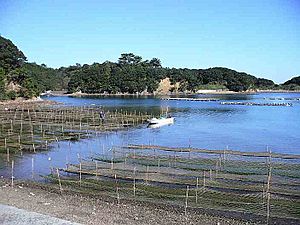Kathleen Mary Drew-Baker facts for kids
Quick facts for kids
Kathleen Mary Drew-Baker
|
|
|---|---|
 |
|
| Born | 6 November 1901 |
| Died | 14 September 1957 (aged 55) Manchester, United Kingdom
|
| Citizenship | United Kingdom |
| Alma mater | University of Manchester (BS, 1922), (MS, 1923), (DSc, 1939) |
| Known for | Study of Porphyra umbilicalis |
| Spouse(s) | Henry Wright-Baker |
| Scientific career | |
| Fields | Botany |
| Institutions |
|
| Influenced | Fusao Ota, Sokichi Segawa |
Kathleen Mary Drew-Baker (born November 6, 1901 – died September 14, 1957) was a British scientist. She studied seaweed, especially a type called Porphyra laciniata, also known as nori. Her amazing research helped people grow nori on a large scale.
In Japan, Kathleen Drew-Baker is highly respected. She is known as the Mother of the Sea. People celebrate her work every year on April 14. A special monument was built for her in 1963. It stands at the Sumiyoshi shrine in Uto, Kumamoto, Japan.
Contents
Early Life & School
Kathleen Mary Drew was born on November 6, 1901. Her hometown was Leigh, Lancashire, in the United Kingdom. She was the older daughter of Walter and Augusta Caroline Drew.
She went to Bishop Wordsworth's School in Salisbury. Kathleen won a special scholarship to study botany (the study of plants). She attended the University of Manchester.
In 1922, she graduated with top honors. She was one of the first two women to achieve this at the university. She continued her studies and earned a Master's degree in 1923. Later, in 1939, she received a higher doctorate degree from the same university.
Her Career in Science
Drew-Baker spent most of her working life at the University of Manchester. She worked in the department that studied cryptogams (plants like mosses and ferns). From 1922 to 1957, she was a lecturer and researcher in Botany.
In 1925, she received a special fellowship. This allowed her to work for two years at the University of California, Berkeley. She even traveled to Hawaii to collect different plant samples.
Kathleen married Henry Wright-Baker in 1928. He was also a professor at Manchester. At that time, the university had a rule against employing married women. Because of this, she was dismissed from her teaching role. However, she continued her important research at the university. She was awarded a research fellowship in the Laboratory of Cryptogamic Botany.
Helping Seaweed Grow: Nori Research
Kathleen Drew-Baker never visited Japan. Yet, her scientific work greatly helped the growth of nori in that country. Nori is a type of edible seaweed, famous for its use in sushi.
Drew-Baker studied the life cycle of a red algae called Porphyra umbilicalis. In 1949, she published her findings in the journal Nature. She discovered that a tiny part of the algae, called Conchocelis, was actually a stage in the Porphyra life cycle. Before her work, scientists thought Conchocelis was a separate type of algae.
Her most important discovery was about the Conchocelis stage. She found that bivalve shells (like clam shells) were essential. These shells provided a perfect home for the tiny algae to grow.
Japanese scientist Sokichi Segawa quickly read Drew-Baker's research. He used her findings to study Japanese nori seaweed. Nori had been harvested in Japan since the 1600s. But harvests were often unpredictable. Storms and pollution could easily ruin them.
By 1953, Japanese marine biologists like Fusao Ota built on Drew-Baker's work. They developed new ways to plant nori seeds artificially. This breakthrough greatly increased nori production. It helped the Japanese seaweed industry grow much stronger.
Because of her huge help to Japanese aquaculture (farming in water), she was called the Mother of the Sea. Since 1953, an annual "Drew festival" is held in Uto, Kumamoto, Japan. A shrine was also built there to honor her.
Between 1924 and 1947, Drew-Baker wrote 47 scientific papers. Most of them were about red algae. She also wrote a book in 1928. It was about different types of algae found on the Pacific Coast of North America.
In 1952, she helped start the British Phycological Society. This group is for scientists who study algae. She was also its first elected president. Her friend and fellow algae scientist, Margaret T. Martin, helped her found the society.
Her Family
Kathleen married Professor Henry Wright-Baker in 1928. He taught at the Manchester College of Science and Technology. They had two children, John Rendle and K. Frances Biggs. Kathleen was a member of the Society of Friends, also known as Quakers.
See also
 In Spanish: Kathleen Mary Drew-Baker para niños
In Spanish: Kathleen Mary Drew-Baker para niños



